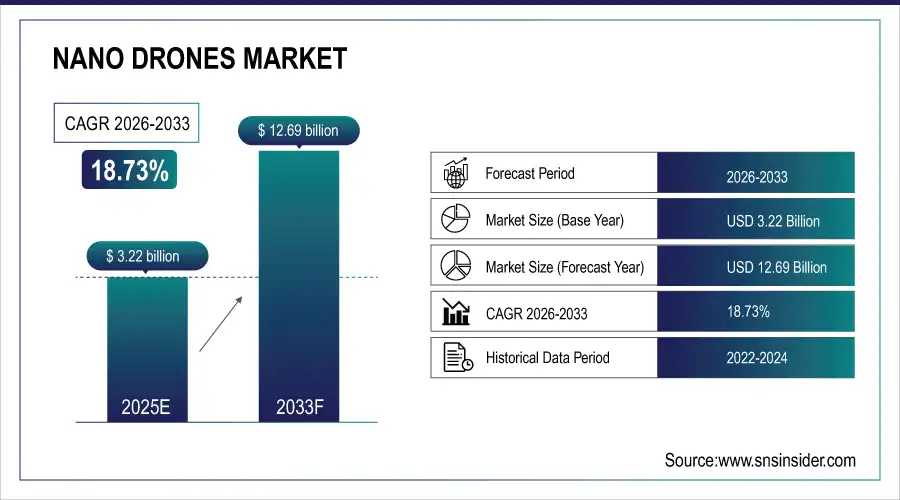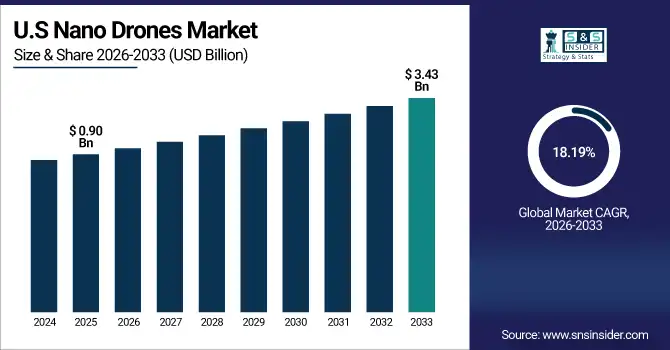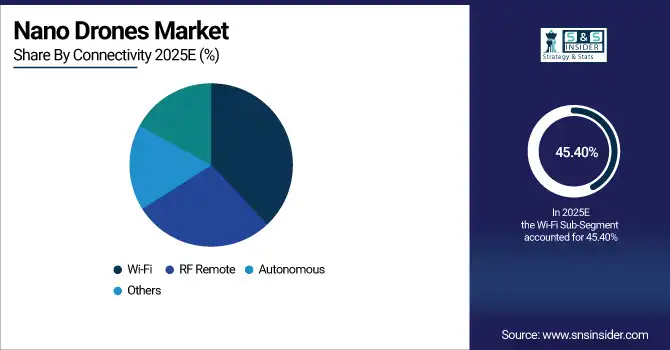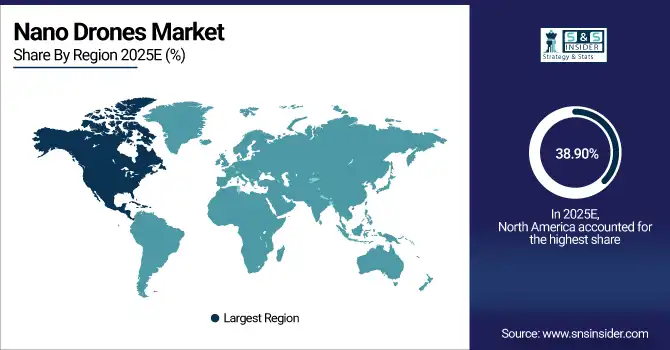Nano Drones Market Report Scope & Overview:
The Nano Drones Market Size was valued at USD 3.22 Billion in 2025E and is expected to reach USD 12.69 Billion by 2033 and grow at a CAGR of 18.73% over the forecast period 2026-2033.
The Nano Drones Market analysis is primarily by increasing demand for compact, lightweight, and highly maneuverable drones across military, commercial, and consumer applications. In the defense sector, nano drones are extensively used for surveillance, reconnaissance, and tactical missions due to their ability to operate in constrained environments and provide real-time intelligence. Technological advancements such as enhanced battery life, high-resolution cameras, autonomous navigation, and AI-based obstacle avoidance have significantly boosted the adoption of nano drones. Additionally, the rise of smart cities, border monitoring initiatives, and the growing need for cost-effective aerial solutions for industrial inspection, agriculture, and environmental monitoring are further propelling market growth. According to study, Autonomous navigation and AI-enabled drones reduce human intervention, leading to a potential 30% improvement in mission completion efficiency compared to manually operated drones.
Market Size and Forecast:
-
Market Size in 2025: USD 3.22 Billion
-
Market Size by 2033: USD 12.69 Billion
-
CAGR: 18.73% from 2026 to 2033
-
Base Year: 2025
-
Forecast Period: 2026–2033
-
Historical Data: 2022–2024

To Get more information On Nano Drones Market - Request Free Sample Report
Nano Drones Market Trends
-
Increasing defense investments drive higher adoption of compact, tactical nano drones.
-
Autonomous navigation enhances operational efficiency in military reconnaissance and surveillance missions.
-
AI-enabled obstacle avoidance improves mission success rates in constrained environments.
-
High-resolution camera integration boosts intelligence gathering capabilities for battlefield operations.
-
Border monitoring and counter-terrorism programs accelerate government drone procurement globally.
-
Lightweight, maneuverable drones reduce operational costs while improving mission effectiveness.
The U.S. Nano Drones Market size was USD 0.90 Billion in 2025E and is expected to reach USD 3.43 Billion by 2033, growing at a CAGR of 18.19% over the forecast period of 2026-2033, driven by advanced technological adoption, extensive defense and commercial applications, high R&D investments, and integration of AI, autonomous navigation, and high-resolution imaging, establishing the country as a global leader in drone innovation.

Nano Drones Market Growth Drivers:
-
Defense Adoption Drives Nano Drones Market Growth Globally and Strategically
The primary growth driver for the Nano Drones Market is their rising adoption in military and defense operations. Nano drones are highly compact, lightweight, and capable of operating in constrained or hazardous environments where larger drones or manned aircraft cannot perform efficiently. They are extensively used for surveillance, reconnaissance, intelligence gathering, and tactical operations, providing real-time video and data to command centers. Technological advancements such as high-resolution cameras, AI-based obstacle avoidance, and autonomous navigation enhance operational efficiency and mission success rates. Governments worldwide are investing heavily in drone programs to strengthen border security, counter-terrorism operations, and battlefield intelligence, which directly fuels the demand for nano drones.
Nano drones account for approximately 40–45% of tactical reconnaissance missions in modern defense operations.
Nano Drones Market Restraints:
-
Regulatory Restrictions and Safety Concerns Challenge Nano Drones Expansion
A significant challenge for the Nano Drones Market is regulatory compliance and safety concerns. Many countries have stringent rules regarding drone flights, airspace restrictions, and payload limitations to ensure civilian safety and prevent unauthorized surveillance. Non-compliance can lead to fines or operational bans, which restricts market growth. Additionally, the compact size and high manoeuvrability of nano drones make them susceptible to accidents or misuse, raising concerns over privacy, security, and safety in urban or crowded areas. These regulatory and operational hurdles slow the widespread adoption of nano drones, especially in commercial and consumer segments.
Nano Drones Market Opportunities:
-
Commercial Applications Offer Significant Growth Potential for Nano Drones Market
Nano drones have enormous opportunities beyond defense, particularly in commercial and industrial sectors. Applications include infrastructure inspection, precision agriculture, environmental monitoring, logistics, and disaster management. Their ability to access hard-to-reach areas, capture high-resolution imagery, and provide real-time data makes them a cost-effective and efficient solution for these sectors. With the integration of IoT, AI, and advanced sensors, nano drones can optimize operations, reduce human labor, and improve safety, creating substantial market opportunities. As industries adopt automation and smart technologies, the demand for nano drones in commercial applications is expected to grow rapidly over the next decade.
About 65% of nano drones in commercial operations provide real-time data and imagery, improving decision-making and operational efficiency.
Nano Drones Market Segmentation Analysis:
-
By Type: In 2025, Rotor Nano Drones led the market with a share of 50.80%, while Flapping Wing is the fastest-growing segment with a CAGR of 16.20%.
-
By Payload: In 2025, Camera led the market with a share of 44.70%, while Tracking Systems is the fastest-growing segment with a CAGR of 15.80%.
-
By Connectivity: In 2025, Wi-Fi led the market with a share of 45.40%, while Autonomous is the fastest-growing segment with a CAGR of 17.10%.
-
By End User: In 2025, Military led the market with a share of 41.80%, while Commercial is the fastest-growing segment with a CAGR of 18.30%.
By Type, Rotor Nano Drones Leads Market and Flapping Wing Fastest Growth
In the Nano Drones Market, Rotor Nano Drones lead the market due to their versatility, compact design, and widespread adoption across military, commercial, and consumer applications. These drones are highly maneuverable, cost-effective, and capable of carrying various payloads such as cameras and sensors, making them ideal for surveillance, inspection, and tactical operations. Meanwhile, Flapping Wing drones are the fastest-growing segment, driven by technological advancements in bio-inspired design and autonomous navigation. Their lightweight structure, energy efficiency, and ability to operate in confined or complex environments are fueling adoption in specialized applications like environmental monitoring, precision agriculture, and indoor surveillance, positioning them as a key growth opportunity in the coming years.
By Payload, Camera Leads Market and Tracking Systems Fastest Growth
In the Nano Drones Market, Camera payloads lead the market due to their critical role in providing high-resolution imagery, real-time video streaming, and surveillance capabilities across defense, commercial, and consumer applications. Cameras enable precise monitoring in sectors such as military reconnaissance, infrastructure inspection, precision agriculture, and environmental surveillance, driving widespread adoption. Meanwhile, Tracking Systems are the fastest-growing payload segment, fueled by advancements in AI, GPS, and sensor technologies that enhance autonomous navigation, object detection, and real-time tracking accuracy. Their increasing integration in commercial logistics, industrial monitoring, and security applications is creating significant growth opportunities, positioning tracking-enabled nano drones as a key market driver in the coming years.
By Connectivity, Wi-Fi Leads Market and Autonomous Fastest Growth
In the Nano Drones Market, Wi-Fi connectivity leads the market due to its widespread use in consumer and commercial drones for short-range control, real-time video streaming, and seamless data transmission. Its cost-effectiveness and ease of integration make it the preferred choice for applications such as surveillance, recreational use, and industrial inspections. Meanwhile, Autonomous connectivity is the fastest-growing segment, driven by advances in AI, GPS, and machine learning technologies that enable drones to navigate independently, avoid obstacles, and execute complex missions with minimal human intervention. Increasing adoption in defense, logistics, agriculture, and industrial monitoring is fueling rapid growth, positioning autonomous-enabled drones as a key market opportunity.

By End User, Military Leads Market and Commercial Fastest Growth
In the Nano Drones Market, the Military segment leads the market due to extensive adoption for surveillance, reconnaissance, intelligence gathering, and tactical operations. Nano drones’ compact design, high manoeuvrability, and ability to operate in constrained or hazardous environments make them indispensable for defense applications, providing real-time data and enhancing mission success rates. Meanwhile, the Commercial segment is the fastest-growing, fueled by rising adoption across industries such as logistics, infrastructure inspection, precision agriculture, and disaster management. Integration with AI, IoT, and advanced sensors allows commercial drones to optimize operations, reduce labor costs, and improve safety, creating significant growth opportunities over the forecast period.
Nano Drones Market Regional Analysis:
North America Nano Drones Market Insights:
The Nano Drones Market in North America held the largest share 38.90% in 2025, driven by advanced defense programs, extensive R&D investments, and early adoption of cutting-edge drone technologies. The region’s strong military infrastructure relies heavily on nano drones for surveillance, reconnaissance, border monitoring, and tactical operations. In addition, growing commercial applications such as precision agriculture, infrastructure inspection, logistics, and emergency response are further fueling market growth. Technological advancements in AI, autonomous navigation, and high-resolution imaging, coupled with supportive government regulations and funding initiatives, reinforce North America’s leadership, positioning it as the most mature and competitive market for nano drones globally.

Get Customized Report as per Your Business Requirement - Enquiry Now
U.S. Dominates Nano Drones Market with Advanced Technological Adoption
The U.S. dominates the Nano Drones Market due to advanced technological adoption, extensive defense applications, high R&D investments, and rapid integration of AI, autonomous navigation, and high-resolution imaging in drones.
Asia-Pacific Nano Drones Market Insights
In 2025, Asia-Pacific is the fastest-growing region in the Nano Drones Market, projected to expand at a CAGR of 19.50%, driven by rapid industrialization, technological adoption, and expanding defense and commercial applications. The region is witnessing strong demand from sectors such as precision agriculture, infrastructure inspection, logistics, and environmental monitoring, where nano drones provide cost-effective, efficient, and real-time solutions. Rising adoption of smart city initiatives and automation technologies is further fueling market growth. Additionally, supportive government policies, increasing R&D investments, and improvements in drone operation regulations are contributing to the region’s accelerated growth trajectory, positioning Asia Pacific as a key emerging market for nano drones in the forecast period.
China and India Propel Rapid Growth in Nano Drones Market
China and India propel rapid growth in the Nano Drones Market through increasing industrial adoption, expanding commercial applications, rising automation, and growing demand for surveillance, precision agriculture, and infrastructure inspection solutions.
Europe Nano Drones Market Insights
Europe holds a significant share in the Nano Drones Market, driven by growing adoption in defense, security, and commercial sectors. Nano drones are widely used for surveillance, reconnaissance, infrastructure inspection, and industrial monitoring due to their compact design, high manoeuvrability, and advanced capabilities. The region benefits from well-established regulatory frameworks, technological innovation, and investments in research and development, which support safe and efficient drone operations. Increasing demand for smart city projects, environmental monitoring, and precision agriculture is further fueling market growth. Europe’s focus on integrating AI, autonomous navigation, and advanced sensors positions it as a strong and competitive nano drones’ market globally.
Germany and U.K. Lead Nano Drones Market Expansion Across Europe
Germany and U.K. lead Nano Drones Market expansion across Europe due to strong adoption in defense, industrial inspection, commercial applications, supportive regulations, and advancements in AI, autonomous navigation, and sensor technologies.
Latin America (LATAM) and Middle East & Africa (MEA) Nano Drones Market Insights
The Latin America (LATAM) and Middle East & Africa (MEA) markets for nano drones are witnessing steady growth, driven by increasing adoption across defense, security, and commercial applications. In LATAM, nano drones are increasingly used for border surveillance, disaster management, infrastructure inspection, and precision agriculture, providing cost-effective and efficient solutions in remote and hard-to-access areas. Similarly, the MEA region is adopting nano drones for military reconnaissance, environmental monitoring, and industrial applications, fueled by investments in technological advancements such as AI, autonomous navigation, and high-resolution imaging. Supportive regulatory frameworks, growing awareness of smart technologies, and rising demand for efficient aerial solutions are collectively propelling market expansion across these emerging regions.
Nano Drones Market Competitive Landscape
DJI Innovations dominates the consumer and commercial nano drones market with compact, high-performance models like the Osmo Nano. Their drones feature 4K cameras, long battery life, and advanced AI navigation, driving widespread adoption in aerial photography, inspection, monitoring, and recreational applications globally.
-
In September 2025, DJI launched the Osmo Nano, an ultra-compact 4K camera weighing 52 grams, featuring a modular design, 143° ultra-wide field of view, and 200-minute battery life.
Parrot SA specializes in commercial and defense nano drones, including the Anafi UKR micro-UAV. Their drones provide autonomous operations in GNSS-denied environments, high-resolution imaging, and tactical surveillance. Parrot’s emphasis on innovation and versatile applications strengthens its market presence, expanding nano drone adoption across security, industrial, and commercial sectors.
-
In June 2025, Parrot introduced the Anafi UKR, a sovereign micro-UAV designed for defense and homeland security, featuring full autonomy in GNSS-denied and jammed zones.
BAE Systems focuses on defense-oriented nano drones, developing weaponized and surveillance UAVs like the Malloy T-150. Their drones enhance tactical operations, electronic warfare, and battlefield intelligence. Adoption in military applications drives growth in precision, safety, and autonomy, positioning BAE Systems as a key player in defense nano drone innovation.
-
In July 2025, BAE Systems developed the Malloy T-150, a weaponized drone equipped with an APKWS laser-guidance kit, enabling it to launch 70-millimeter rockets to intercept and destroy other drones.
Nano Drones Market Key Players:
Some of the Nano Drones Market Companies are:
-
DJI Innovations
-
AeroVironment Inc.
-
Parrot SA
-
Lockheed Martin Corporation
-
BAE Systems plc
-
Hubsan Technology Company Ltd.
-
Thales Group
-
Draganfly Innovations
-
Skydio Inc.
-
Northrop Grumman Corporation
-
Textron Inc.
-
Delair
-
Teal Drones
-
Yuneec International
-
Aero Sentinel
-
Flyability SA
-
Altavian Inc.
-
Microdrones GmbH
-
senseFly
-
Terra Drone Corporation
| Report Attributes | Details |
|---|---|
| Market Size in 2025E | USD 3.22 Billion |
| Market Size by 2033 | USD 12.69 Billion |
| CAGR | CAGR of 18.73 % From 2026 to 2033 |
| Base Year | 2025E |
| Forecast Period | 2026-2033 |
| Historical Data | 2022-2024 |
| Report Scope & Coverage | Market Size, Segments Analysis, Competitive Landscape, Regional Analysis, DROC & SWOT Analysis, Forecast Outlook |
| Key Segments | • By Type (Rotor Nano Drones, Fixed Wing Nano Drones, Flapping Wing, Others) • By Payload (Camera, Control Systems, Tracking Systems, Others) • By Connectivity (Wi-Fi / Bluetooth, RF Remote, Autonomous (GPS / SLAM), Others) • By End User (Consumer, Military / Law Enforcement, Commercial, Others) |
| Regional Analysis/Coverage | North America (US, Canada), Europe (Germany, UK, France, Italy, Spain, Russia, Poland, Rest of Europe), Asia Pacific (China, India, Japan, South Korea, Australia, ASEAN Countries, Rest of Asia Pacific), Middle East & Africa (UAE, Saudi Arabia, Qatar, South Africa, Rest of Middle East & Africa), Latin America (Brazil, Argentina, Mexico, Colombia, Rest of Latin America). |
| Company Profiles | DJI Innovations, AeroVironment Inc., Parrot SA, Lockheed Martin Corporation, BAE Systems plc, Hubsan Technology Company Ltd., Thales Group, Draganfly Innovations, Skydio Inc., Northrop Grumman Corporation, Textron Inc., Delair, Teal Drones, Yuneec International, Aero Sentinel, Flyability SA, Altavian Inc., Microdrones GmbH, senseFly, Terra Drone Corporation, and Others. |

